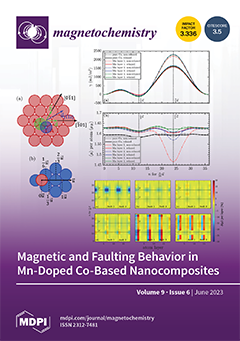Ferrites have excellent magnetic, electric, and optical properties that make them an indispensable choice of material for a plethora of applications, such as in various biomedical fields, magneto–optical displays, rechargeable lithium batteries, microwave devices, internet technology, transformer cores, humidity sensors, high-frequency media, magnetic
[...] Read more.
Ferrites have excellent magnetic, electric, and optical properties that make them an indispensable choice of material for a plethora of applications, such as in various biomedical fields, magneto–optical displays, rechargeable lithium batteries, microwave devices, internet technology, transformer cores, humidity sensors, high-frequency media, magnetic recordings, solar energy devices, and magnetic fluids. Recently, magnetically recoverable nanocatalysts are one of the most prominent fields of research as they can act both as homogeneous and heterogenous catalysts. Nano-ferrites provide a large surface area for organic groups to anchor, increase the product and decrease reaction time, providing a cost-effective method of transformation. Various organic reactions were reported, such as the photocatalytic decomposition of a different dye, alkylation, dehydrogenation, oxidation, C–C coupling, etc., with nano-ferrites as a catalyst. Metal-doped ferrites with Co, Ni, Mn, Cu, and Zn, along with the metal ferrites doped with Mn, Cr, Cd, Ag, Au, Pt, Pd, or lanthanides and surface modified with silica and titania, are used as catalysts in various organic reactions. Metal ferrites (MFe
2O
4) act as a Lewis acid and increase the electrophilicity of specific groups of the reactants by accepting electrons in order to form covalent bonds. Ferrite nanocatalysts are easily recoverable by applying an external magnetic field for their reuse without significantly losing their catalytic activities. The use of different metal ferrites in different organic transformations reduces the catalyst overloading and, at the same time, reduces the use of harmful solvents and the production of poisonous byproducts, hence, serving as a green method of chemical synthesis. This review provides insight into the application of different ferrites as magnetically recoverable nanocatalysts in different organic reactions and transformations.
Full article





